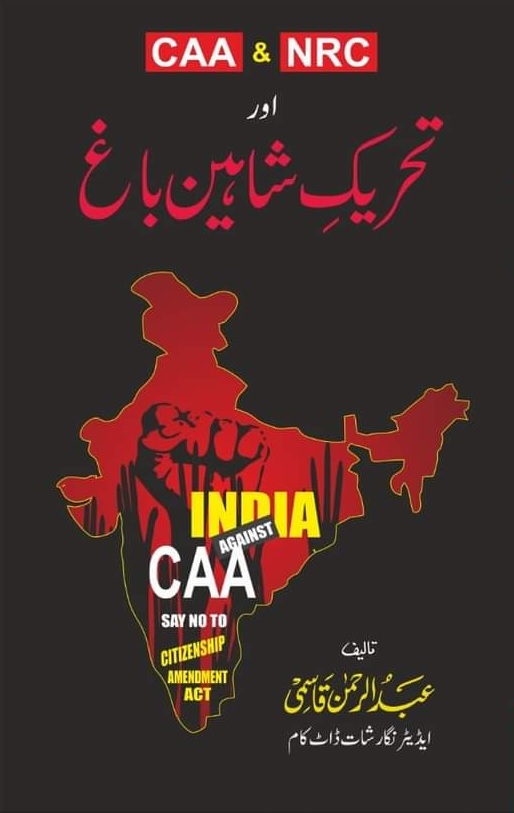
Shaheen Bagh: From ‘Anti-National’ to Nation Saviour
Author: Asad
Publisher: Zavia Publications
Pages: 264
Price ₹400
CAA & NRC aur Tehreek-e-Shaheen Bagh
Author: Abdur Rahman Qasmi. Markazi Publications
Pages: 248
Price: ₹250
Reviewed by M Ghazali Khan
With an eye on the general election, India’s Hindu supremacist government has implemented the ignoble Citizenship Amendment Act (CAA), ostensibly aimed at granting Indian nationality to non-Muslim asylum seekers from Pakistan, Afghanistan, and Bangladesh.

The controversial law is yet another step towards Hinduising the secular character of the constitution, which guarantees equal rights to all its citizens regardless of race, religion, caste, or creed.
Even more dangerous than the CCA is its affiliated National Register of Citizens (NRC), a register of residents who can prove that they came to India before Bangladesh was founded on March 24, 1971.
Any non-Muslim unregistered in the NRC will have an expedited procedure to apply for citizenship, while their Muslim counterparts will be declared illegal migrants and dumped in Nazi-like camps.
Muslims of Assam are worst hit by the discriminatory law; according to Hindutva Chief Minister Himanta Biswa Sarma, of the 1.9 million residents excluded from the NRC, 0.7 million are Muslims.
Civil and human rights organisations have condemned the CAA as a blow to the Indian constitution. Chair of Amnesty’s India Board, Aakar Patel, dubbed the CAA ‘a bigoted law that legitimises discrimination on the basis of religion.’
The discriminatory law was passed by Parliament in 2019 but was put on hold following a massive sit-in protest by Muslim women in New Delhi’s Shaheen Bagh district that began on December 15, 2019, and lasted until March 24, 2020.
The sit-in sparked similar protests in 210 different cities, including Bangalore (Karnataka), Mumbai (Maharashtra), Malerkotla (Punjab), Ranchi (Jharkhand), Lucknow, Kanpur & Deoband (Uttar Pradesh), and Chennai (Tamil Nadu). Taking their name from the original protest site, the Shaheen Bagh of Delhi, these sit-in protests were also named ‘Shaheen Bagh.’
The well-organized, organic, and peaceful sit-in caught the attention of the international media, much to the embarrassment of the central government.
Unable to legally curb them, government agents, lobbies, and brazenly pro-government godi media (translation sitting on the lap) launched smear campaigns against the participants.
Failing in their bid to demoralise and intimidate these brave women through dirty means, the detractors, at last, engineered an anti-Muslim riot in Northeast Delhi in which 53 people, mostly Muslims, were killed, 581 were injured, and properties worth millions of rupees destroyed. Young Muslim leaders were arrested, and many remain incarcerated.
The two books under review, Shaheen Bagh: From Anti-national to Nation Saviour, written in English by Delhi-based journalist and Editor of news portal Okhla Times, and another CAA & NRC aur Tehreek-e-Shaheen Bagh (CAA & NRC and Shaheen Bagh Movement), written in Urdu by Abdur Rahman Qasmi, a young student of Darul Uloom Deoband and Editor of negarishat.com, are valuable additions to the history of a unique movement and protest.
Abdur Rahman Qasmi has covered every aspect of the protest he aptly calls a ‘movement.’ It contains introductions by two eminent Indian journalists, Dr Zafarul Islam Khan, Editor of the Milli Gazette, and Wadood Sajid, Editor of the Urdu daily Inquilab.
Dedicating the book to the martyrs of the Shaheen Bagh Movement, those who are having to pay the price for their courage with the ongoing incarceration, and the brave women who participated in it and men who supported it, Qasmi covers almost every aspect related to the protest, starting with a detailed chapter on CAA and NRC, its implications, the government’s unfair and unjust attitude towards Muslims, and comprehensive details of how the godi media tried to malign the women participants.
Perhaps no other book has been written on this unique and women-only protest that brought to light the resilience, courage, and determination of Muslim women, generally and wrongly perceived as docile, who came out of their houses and registered their protest in major cities of India against an unfair and absurd law.
Qasmi also provides the introduction and educational backgrounds of the leading participants, many of whom are still languishing in jails charged with fabricated accusations of terrorism and sedition. Interestingly, far from having criminal records, most are, or were, students with brilliant academic records.
For 101 days and nights, women of all ages and backgrounds sat under the open sky in Delhi’s Shaheen Bagh and other cities, braving the torrential rain and harsh cold of December, until the COVID pandemic forced them to pause their protests.
Even after the Corona outbreak, these courageous women were not ready to end the protest and return to their homes. As one protestor told The Wire, ‘We understand that the coronavirus outbreak is deadly, but for us, CAA, NPR, and NRC are equally deadly.’
Indian media has, for the most part, been hostile towards Muslims. The Shaheen Bagh protest provided it with yet another opportunity to brand Muslims as ‘anti-social,’ ‘anti-Indian,’ and ‘Pakistani agents,’ etc. It is said that during storms, even animals in the jungle refrain from harming one another.
However, a large section of Indian media proved to be worse than animals, and during the first wave of the coronavirus, it did not relent in its anti-Muslim hate-mongering. It accused them of spreading COVID through what they called ‘corona jihad’ and ‘spit jihad,’ implying that Muslim vendors were spreading the deadly disease by spitting on their produce.
This was despite the fact that Muslims went out of their way to help anyone and everyone, regardless of their religious background. Some Muslim youths even helped perform the last rites of the dead, abandoned by their own families. Asad’s ‘Shaheen Bagh: From anti-national to Nation Saviour’ covers this period.
He narrates moving stories of selfless and brave Muslim youths who risked their lives to arrange oxygen cylinders for patients and even helped them financially. The book is packed with inspiring stories of Muslims helping desperate people.
Mohammad Saghir Abbasi, a 65-year-old Arabic translator who also runs the Sudhar Trust, assists patients and their relatives. But helping Sunjay, a Hindu from Bengal who had no one in Delhi to help him perform the last rites of his dead mother, was a distinct experience.
‘You need not worry. We will do everything. Your mother is like our mother,’ Abbasi assured Sunjay. Under Sunjay’s guidance, he and his team cremated Sunjay’s mother at the Okhla Colony. ‘Our team members did everything—from purchasing materials for cremation from Kalkaji to transporting the body from Holy Family Hospital to the cremation ground,’ Abbasi told Asad.
Such stories abound in the media and social media during the outbreak, and Muslims were appreciated for their selflessness and crossing communal lines in helping the needy. Unfortunately, in the coronavirus phase, all their services have been forgotten.
The media has started the usual anti-Muslim campaign, and its consumers have started believing it.
However, these two books have preserved the history of an important movement and the positive and constructive roles played by its participants. Maybe these books will help some honest souls see the real and magnificent picture hidden behind the tarnished and ugly image created by the media.
